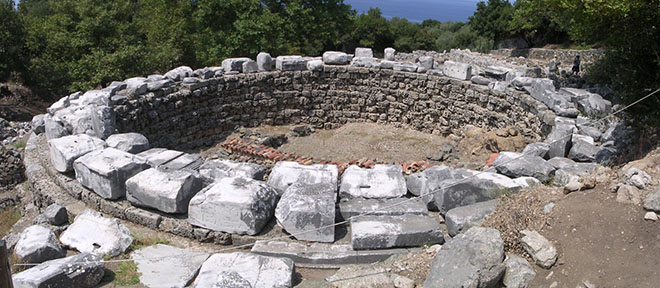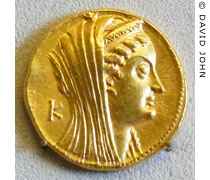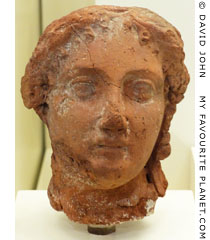|
|
 |
| My Favourite Planet > English > Europe > Greece > Northern Aegean > Samothraki > gallery |
 |
| Samothraki, Greece |
Samothraki gallery |
 |
 |
15 of 46 |
 |
 |
|
 |

Sanctuary of the Great Gods. Remains of the Arsinoe Rotonda, 288-270 BC. |
| |
The Arsinoe Rotonda, also known as the Arsinoeion, built between 288 and 270 BC, was a large circular building (tholos), 20.2 metres in diameter, the largest ancient Greek rotunda. The cylindrical walls were decorated with 44 engaged Doric pilasters, topped by a frieze of triglyphs and metopes and a conical roof. Inside the building, in place of the external pilasters was a colonnade of Corinthian half-columns. At the base of the exterior and interior columns were relief panels decorated with boukrania (bull's heads), phialai (libation bowls) and rosettes [1].

The function of the rotunda is unknown, however altars and shafts for libations as well as the reliefs decorated with rosettes and garlanded bulls' heads (now in the museum) suggest that it was used for sacrifices. According to another theory the building was used for the reception of delegates from Greek cities to the festivals at the sanctuary.

The building of the Rotonda was financed by Queen Arsinoe II of Egypt (Ἀρσινόη B' ἡ Φιλάδελφος, 316 BC - circa 270-260 BC). Arsinoe was the daughter of Ptolemy I, one of Alexander the Great's generals, who became the first Hellenistic pharoah of Egypt after Alexander's death. At the age of 15 she was married to Lysimachus (Λυσίμαχος, circa 360-281 BC), another of Alexander's generals who had taken over Thrace and part of Anatolia (Asia Minor), including Pergamon.

After the death of Lysimachus, she fled to Cassandreia (Κασσάνδρεια, Kassandreia; see History of Stageira and Olympiada Part 6) in Halkidiki and married her half-brother Ptolemy Keraunos (Πτολεμαῖος Κεραυνός, Ptolemy Thunderbolt; died 279 BC) who had been acclaimed king of Macedonia by the army. Arsinoe schemed against Keraunos, and after he killed two of her sons by Lysimachus (Lysimachus and Philip) in 279 BC, she took refuge on Samothraki. Fortunately for Arsinoe, Keraunos was captured and killed shortly after by Bolgius, leader of the Gauls who invaded Macedonia.

Returning to Egypt, she married her brother Ptolemy II Philadelphos (Πτολεμαῖος Φιλάδελφος, Ptolemy the sibling-loving, 309-246 BC) in 278 BC, and thus became co-ruler. Ptolemy II also financed the building of a propylon (monumental gateway) at the Sanctuary of the Great Gods (see gallery page 18).

At the time the Ptolemies owned several Aegean islands, including Samothraki and probably its colonies on the Thracian mainland such as Maroneia. [2]

Only the foundation of the Rotonda can now be seen, as well as some of the marble blocks of the building, including parts of Arsinoe's dedicatory inscription which have been placed on top of it. |


Gold oktodrachm with the
head of Arsinoe II of Egypt.
283-245 BC.

Bode Museum, Berlin. |
| |

Gold oktodrachm with
depictions of Ptolemy II
and Arsinoe II of Egypt.
260-240 BC.

Altes Museum, Berlin. |
| |

Terracotta head of Arsinoe II.

National Archaeological
Museum, Athens. Egyptian
Collection, Inv. No. 48. |
| |
| |
| Samothraki |
Notes, references and links |
 |
|

1. Sculptural decoration of the Rotunda of Arsinoe

See: Pamela A. Webb, Hellenistic Architectural Sculpture: Figural Motifs in Western Anatolia and the Aegean Islands, page 148. University of Wisconsin Press, 1996.

2. The Egyptian Empire of the Ptolemies

The territories of the Ptolemaic kings beyond Egypt were gained during the wars of the Diadochi, the successors of Alexander the Great, the most successful of which founded dynasties that carved out empires from the enormous areas of Greece, Thrace, Asia and north Africa conquered by Alexander. The most important players were the Ptolemies of Egypt, the Seleucids of Syria and the Attalids of Pergamon.

To the east of Egypt the Ptolemies controlled Cyprus and the Levant, covering what are today Israel and Lebanon; and to the west Cyrenaica (Cyrene), which covered modern Libya, Tunisia and Algeria. In the Aegean they controlled the Cycladic islands, including Andros, Naxos, Mykonos and Delos, as well as Samos, Lesbos and Samothraki. Not much is known of the situation at the colonies of Samothraki on the Thracian coast, which included Maroneia and Sale, the location of modern Alexandroupoli.

They had an enormous army and navy, and were constantly forced to defend these external territories from attack, particularly by the Seleucids. By 200 BC, at the end of the Fifth Syrian War, they had lost all except Cyrenaica and Cyprus.

See, for example: Alan K. Bowman, Egypt after the pharoahs 332 BC - AD 642, from Alexander to the Arab conquest (Particularly Chapter 2, The ruling power). British Museum Press, London, 1986. |
|
|
Photos, maps and articles: © David John,
except where otherwise specified.
All photos and articles are copyright protected.
Images and materials by other authors
have been attributed where applicable.
Please do not use these photos or articles without permission.
If you are interested in using any of the photos for your website,
project or publication, please get in contact.
Higher resolution versions are available on request.
Some of the information and photos in this guide to Samothraki
originally appeared in 2004 on davidjohnberlin.de.
My Favourite Planet makes great efforts to provide comprehensive and accurate information across this website. However, we can take no responsibility for inaccuracies or changes made by providers of services mentioned on these pages. |
|
| |
 |
Visit the My Favourite Planet Group on Facebook.

Join the group, write a message or comment,
post photos and videos, start a discussion... |
|
|
 |
|
|
| |
| |
 |
| |
 |
| |
 |
| |
 |
| |

George Alvanos

rooms
in Kavala's historic Panagia District

Anthemiou 35,
Kavala, Greece

kavalarooms.gr
 |
| |
|